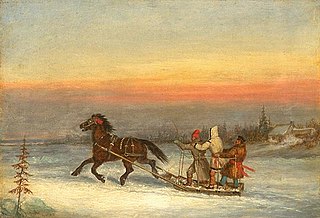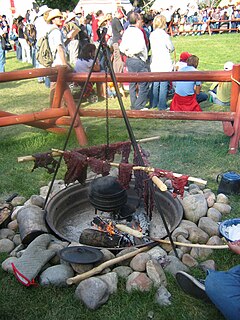 W
WBungi is a dialect of English with substratal influence from Scottish English, the Orcadian dialect of Scots, Norn, Scottish Gaelic, French, Cree, and Ojibwe (Saulteaux). It was spoken by the Scottish Red River Métis in present-day Manitoba, Canada.
 W
WA capote or capot is a long coat with a hood.
 W
WThe ceinture fléchée [sɛ̃tyʁ fleʃe] is a type of colourful sash, a traditional piece of French-Canadian clothing linked to at least the 17th century. The Métis also adopted and made ceintures fléchées and use them as part of their national regalia. French-Canadian and Métis communities share the sash as an important part of their distinct cultural heritages, nationalities, attires, histories and resistances. While the traditional view is that the ceinture fléchée is a French-Canadian invention, other origins have been suggested as well including the traditional fingerwoven Gaelic crios. According to Dorothy K. Burnham who prepared an exhibit on textiles at the National Gallery of Canada in 1981, and published an accompanying catalogue raisonné, this type of finger weaving was learned by residents of New France from Indigenous peoples. With European wool-materials, the syncretism and unification of French and Indigenous finger-weaving techniques resulted in the making of Arrowed Sashes. L'Assomption Sash is the oldest known sash design; produced by French habitants or artisans in Québec.
 W
WNative American cuisine includes all cuisines and food practices of the indigenous peoples of the Americas. Contemporary Native peoples retain a varied culture of traditional foods, along with the addition of some post-contact foods that have become customary and even iconic of present-day Native American social gatherings. Foods like cornbread, turkey, cranberry, blueberry, hominy and mush have been adopted into the cuisine of the broader United States population from Native American cultures.
 W
WHivernants was used during the North American fur trade to describe Métis who spent the winter months hunting and trapping on the Canadian prairies where they built small temporary villages. The word is French for "winterer". "Hiverner" the verb means to overwinter.
 W
WLouis Riel is a historical biography in comics by Canadian cartoonist Chester Brown, published as a book in 2003 after serializion in 1999–2003. The story deals with Métis rebel leader Louis Riel's antagonistic relationship with the newly established Canadian government. It begins shortly before the 1869 Red River Rebellion, and ends with Riel's 1885 hanging for high treason. The book explores Riel's possible schizophrenia—he believed God had named him Prophet of the New World, destined to lead the Métis people to freedom.
 W
WPânsâwân, or dry meat, is a type of dried smoked meat product made by the indigenous peoples of Canada including the Cree, Dene, and Métis. The term is loosely translated from the Cree language as "thin-sliced meat" with the meat used for its production from bison, elk, or moose. It is commonly made in the indigenous community, considered a delicacy, and is also culturally significant.
 W
WPemmican is a mixture of tallow, dried meat, and sometimes dried berries. A caloric rich food, it can be used as a key component in prepared meals or eaten raw. Historically, it was an important part of indigenous cuisine in certain parts of North America and it is still prepared today. The word comes from the Cree word ᐱᒦᐦᑳᓐ, which is derived from the word ᐱᒥᕀ, "fat, grease". The Lakota word is wasná, originally meaning "grease derived from marrow bones", with the wa- creating a noun, and sná referring to small pieces that adhere to something. It was invented by the Indigenous peoples of North America.
 W
WPoutchine au sac is a Métis dish made of beef suet, flour, brown sugar, raisins, currants, and milk. The ingredients are combined in a cotton bag or sealer jars, then steamed. The cooked dish is usually topped with a sauce made from sugar, cornstarch, vanilla and nutmeg.
 W
WRubaboo is a common stew or porridge consumed by coureurs des bois and voyageurs and Métis people of North America. This dish is traditionally made of peas and/ or corn, with grease and a thickening agent that makes up the base of the stew. Pemmican and maple sugar were also commonly added to the mixture. Rubaboo that is made by the Plains Metis is often made with pemmican, rabbit, prairie chicken or sage hen and a wide variety of wild vegetables such as wild parsnip onion, turnip, and asparagus that can all be added to the food with preference. The thickened mixture was later re-served as “rowschow” (re-chaud). Sometimes, It is occasionally spelled Rubbaboo. Other sources describe it as consisting primarily of boiled pemmican, with thickening agents added when available.